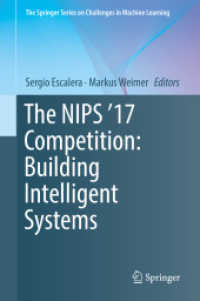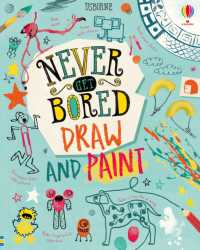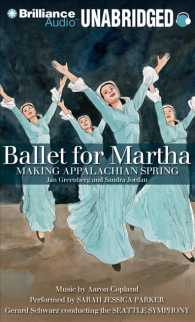Full Description
"This book should make educators stop and consider exactly what they mean when they discuss curriculum integration."
—Julie Prescott, Assessment Coordinator
Vallivue High School, Caldwell, ID
"The biggest strength of Fogarty's work is its clear, concise organization centered on the guiding questions of each chapter."
—John C. Baker, Eighth-Grade Social Studies Teacher
Salem Middle School, Apex, NC
Strategies for moving students towards more holistic and authentic types of learning!
For both students and teachers, the mission is essential: to connect ideas, discern themes, and thread skills of various content areas into a cohesive whole. Yet, the question remains: "What does integrating the curricula really mean?" The answers are provided in this updated resource that helps teachers create brain-compatible, learner-centered classrooms and better prepare students for lifelong learning.
Based on a four-pronged rationale for using an integrated curriculum—including findings from brain-based research, parental concerns, practitioner challenges, and student perspectives—Robin Fogarty offers ten models that allow teams of teachers to work together to group elements from various content areas into a coherent curriculum that effectively meets standards. The discussion of each model includes:
A description of the model
How the model can be applied in the classroom
Benefits and challenges of the model for teaching and learning
Guidelines for when and how to implement the model in the classroom
A wealth of reproducibles to aid implementation
How to Integrate the Curricula offers the support educators need to integrate concepts, skills, and attitudes and immerse students in content through self-selected, personally relevant learning experiences.
Contents
Foreword by Heidi Hayes Jacobs
Acknowledgments
About the Author
Introduction
What Is This Book All About?
Why Bother?
The Theorists: Research on the Brain and Learning
The Practitioners: Abandonment of an Overloaded Curriculum and Adherence to Standards of Learning
The Parents: What Will Our Children Need 25 Years From Now?
The Students: Education Is a Vaccination
How Can the Curriculum Be Integrated?
10 Models of Integrating the Curricula
Agree/Disagree Introductory Activity
Four-Fold Concept Development Activity
Examples of the Four-Fold Concept Development Activity
How Do Teachers Use This Book?
1. Model 1: Cellular
What Is the Cellular Model?
What Does It Look Like?
What Does It Sound Like?
What Are the Advantages?
What Are the Disadvantages?
When Is This Cellular Model Useful?
How to Integrate the Curricula Working With Model 1: Cellular
2. Model 2: Connected
What Is the Connected Model?
What Does It look Like?
What Does It Sound Like?
What Are the Advantages?
What Are the Disadvantages?
When Is This Connected Model Useful?
How to Integrate the Curricula Working With Model 2: Connected
3. Model 3: Nested
What is the Nested Model?
What Does It Look Like?
What Does It Sound Like?
What Are the Advantages?
What Are the Disadvantages?
When Is This Nested Model Useful?
How to Integrate the Curricula Working With Model 3: Nested
4. Model 4: Sequenced
What Is the Sequenced Model?
What Does It Look Like?
What Does It Sound Like?
What Are the Advantages?
What Are the Disadvantages?
When Is This Sequenced Model Useful?
How to Integrate the Curricula Working With Model 4: Sequenced
5. Model 5: Shared
What Is the Shared Model?
What Does It Look Like?
What Does It Sound Like?
What Are the Advantages?
What Are the Disadvantages?
When Is This Shared Model Useful?
How to Integrated the Curricula Working With Model 5: Shared
6. Model 6: Webbed
What Is the Webbed Model?
What Does It Look Like?
What Does It Sound Like?
What Are the Advantages?
What Are the Disadvantages?
When Is This Webbed Model Useful?
How to Integrate the Curricula Working With Model 6: Webbed
7. Model 7: Threaded
What Is the Threaded Model?
What Does It Look Like?
What Does It Sound Like?
What Are the Advantages?
What Are the Disadvantages?
When Is This Threaded Model Useful?
How to Integrate the Curricula Working With Model 7: Threaded
8. Model 8: Integrated
What Is the Integrated Model?
What Does It Look Like?
What Does It Sound Like?
What Are the Advantages?
What Are the Disadvantages?
When Is This Integrated Model Useful?
How to Integrate the Curricula Working With Model 8: Integrated
9. Model 9: Immersed
What Is the Immersed Model?
What Does It Look Like?
What Does It Sound Like?
What Are the Advantages?
What Are the Disadvantages?
When Is This Immersed Model Useful?
How to Integrate the Curricula Working With Model 9: Immersed
10. Model 10: Networked
What Is the Networked Model?
What Does It Look Like?
What Does It Sound Like?
What Are the Advantages?
What Are the Disadvantages?
When Is This Networked Model Useful?
How to Integrate the Curricula Working With Model 10: Networked
Appendix A: Assessing Curriculum Integration: Units of Study
Appraising Curriculum Integration
Appraising the Integrity of the Breadth and Depth of the Curriculum Integration Unit
Sample Rubric
Assessing the Effectiveness of the Unit in
Terms of Student Achievement
General Rubric
History Rubric
Language Arts Rubric
Conclusion
References
Index








